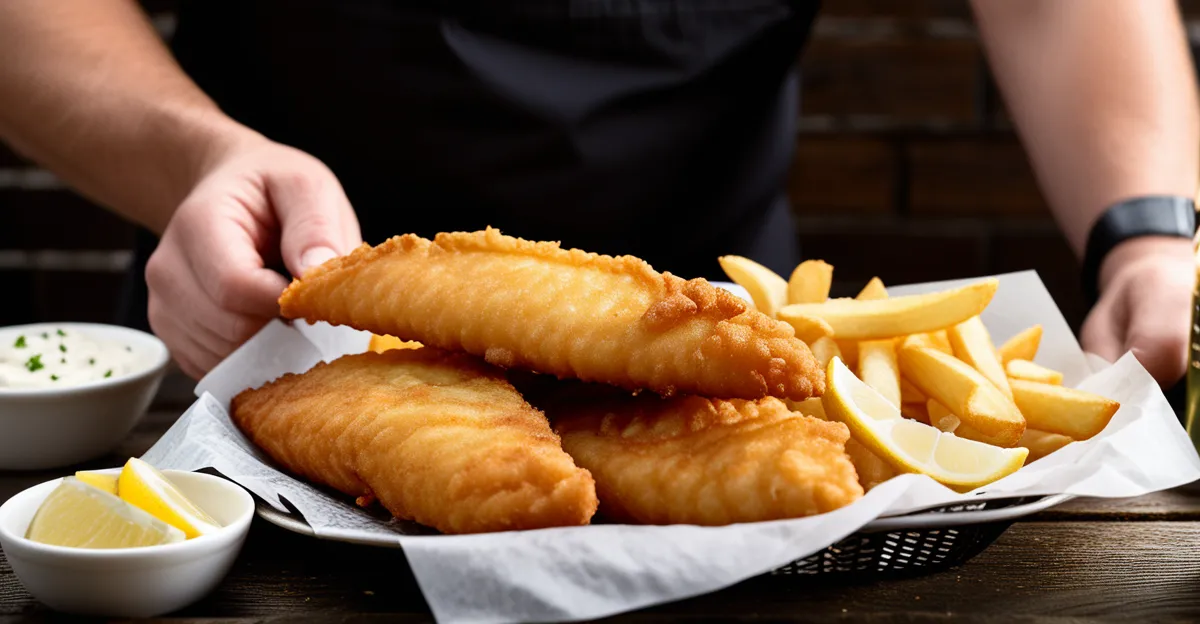Essential Ingredients and Equipment for Perfect Fish and Chips
Choosing the right fish and chips ingredients is foundational for authentic flavour and texture. The best fish options for traditional fish and chips are firm, white-fleshed varieties like cod, haddock, or pollock. These provide a delicate, flaky texture when fried. When selecting fish, freshness is key — look for moist, shiny fillets without a strong fishy odour.
High-quality potatoes are equally important for perfect chips. Russet or Maris Piper potatoes are preferred for their starchy content, ensuring fluffy interiors and crisp exteriors. Oil selection also plays a crucial role: vegetable or sunflower oils with a high smoke point allow for consistent frying without burning, preserving the ideal chip texture.
Also to read : What are the best practices for cooking a tender roast beef?
Owning the right professional kitchen tools greatly influences results. For home cooks, a sturdy deep fryer or a heavy-bottomed pan helps maintain steady oil temperature. A reliable thermometer ensures precise temperature control, essential for crispiness. Additionally, a slotted spoon or frying basket aids in handling food safely, while paper towels or a wire rack allow excess oil to drain, keeping fish and chips light.
With these carefully chosen fish and chips ingredients alongside essential equipment, home cooks set the stage for recreating this classic dish with impressive results.
Also read : How can you make a gluten-free version of a classic scone?
Preparing the Fish: Techniques for Flavour and Texture
Mastering preparing fish starts with selecting the right fillets. When preparing fish fillets, always cut against the grain to ensure tenderness. Properly drying the fillets before cooking is crucial—moisture on the surface can prevent a crispy coating and lead to sogginess. Use paper towels to pat the fish completely dry.
Marinating fish can enhance flavour subtly without overpowering the traditional taste. A light marinade of lemon juice, salt, and a pinch of white pepper works best. Avoid heavy seasonings or acidic marinades that can alter the texture or mask the fish’s natural flavour.
Common mistakes when preparing fish include skipping the drying step, over-marinating, or cutting fillets inconsistently. These issues often cause uneven cooking or a soggy batter. To achieve that signature flaky yet firm texture, handle the fish gently, season lightly, and ensure the fillets are dry before moving on to battering and frying.
Following these expert tips will help you unlock the full potential of your fish fillets, laying the foundation for perfect fish and chips.
Creating the Perfect Batter for Crispiness
The secret to a light, crispy fish and chips batter lies in its ingredients and preparation. A classic batter combines cold sparkling water or beer with plain flour and a pinch of baking powder. This creates a delicate, airy texture essential for crispiness. The cold liquid slows gluten development, preventing heaviness.
Chilling the batter before use is crucial. Resting it in the refrigerator for at least 30 minutes firms up the mixture, improving the crunch when fried. This step enhances the batter’s ability to cling to fish fillets evenly, avoiding soggy spots.
When mixing, combine ingredients gently to retain air bubbles—over-mixing can produce a dense batter. Dip the dried fish fillets fully, letting excess batter drip off to avoid thick layers that cook unevenly.
For an extra crispy coating, some chefs add cornstarch or rice flour to the batter mix. This modification further reduces sogginess by absorbing moisture during frying, ensuring your fish and chips have that irresistible crunch.
Mastering these crispy batter techniques transforms your dish from basic to exceptional, capturing the classic appeal that defines perfect fish and chips every time.
Mastering Frying Techniques for Golden Results
Achieving crispy fish and chips hinges on precise frying methods and careful temperature control. Maintaining oil temperature between 175°C and 190°C (350°F to 375°F) ensures the batter crisps quickly without absorbing excess oil. Frying at too low a temperature leads to greasy results, while too high risks burning the coating before the inside is cooked.
The double frying method is fundamental for perfect chips. First, fry cut potatoes at a lower temperature (around 130°C or 265°F) to cook them through without browning. Drain and cool before a second fry at a higher temperature (around 190°C or 375°F) to achieve a golden, crunchy exterior with fluffy interiors. This technique also applies to fish fillets to maintain juiciness inside a crisp shell.
Timing synchronization matters: fry chips first because they take longer, then fry the fish last to serve everything hot. Using a thermometer and a slotted spoon helps manage frying and removal efficiently.
Adopting these expert frying methods guarantees restaurant-quality crispy fish and chips every time, combining texture, flavour, and appearance flawlessly.







